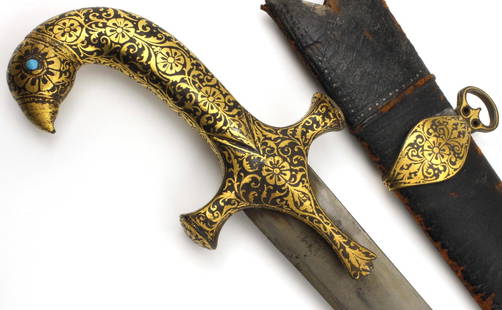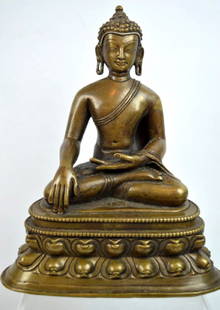
18th C. Indian Bronze Die of Venetian Ducat / Zecchino
Similar Sale History
View More Items in CollectiblesRelated Collectibles
More Items in Collectibles
View More




Item Details
Description
South Asia, India, ca. 18th to 19th century CE. A rare bronze die for creating coins, comprised of a cylindrical body and circular stamp face cast in India for replicating the Venetian ducat known as a zecchino. The bronze stamp face is of course backwards, and features a kneeling dodge, a member of the Venetian political elite receiving a standard from Saint Mark. The inscription on the left is “S M VENET” for Saint Mark of Venice, and in the center is the dodge’s title “DVX.” Included is a putty impression of the stamp to show the correct orientation of the final cast coins. The gold zecchino coins were minted in Venice and used by traders, colonizers, and missionaries spread throughout Asia. Ducats served as the model for other currencies throughout Europe during the coinage reforms of the 16th through early 18th centuries. These ducats were valued in India for their dependable gold purity and weight. This die is an example of the Indian production of imitation ducats. While this one contains the Venetian and Christian symbolism, some Indian dies replaced Saint Mark and the dodge with Hindu deities such as Radha and Krishna! Size: 0.85" L x 0.85" Diameter (2.2 cm x 2.2 cm)
During the 15th century, as Europe and its traders/colonizers/missionaries spread throughout the world, merchants began to shift their business currency from the florin to the ducat. Ducats served as the model for other currencies throughout Europe during the coinage reforms of the 16th, 17th, and, in the case of England, the early 18th centuries, as European rulers standardized their coinage. The gold Venetian ducat was renamed "zecchino" in the mid-16th century when Venice began minting a silver coin also called a ducat. The word zecchino comes from the Arabic word “sikka” which means a die or coin mold.
For more information see Ives, Herbert E., The Venetian Gold Ducat and its Imitations, ANS Numismatic Notes and Monographs 128, pp.25-28 and pls. XIII and XVI.
Provenance: ex-estate of Eldert Bontekoe, Pegasi Numismatics, Ann Arbor, Michigan, USA acquired before 2000
All items legal to buy/sell under U.S. Statute covering cultural patrimony Code 2600, CHAPTER 14, and are guaranteed to be as described or your money back.
A Certificate of Authenticity will accompany all winning bids.
We ship worldwide to most countries and handle all shipping in-house for your convenience.
#158468
During the 15th century, as Europe and its traders/colonizers/missionaries spread throughout the world, merchants began to shift their business currency from the florin to the ducat. Ducats served as the model for other currencies throughout Europe during the coinage reforms of the 16th, 17th, and, in the case of England, the early 18th centuries, as European rulers standardized their coinage. The gold Venetian ducat was renamed "zecchino" in the mid-16th century when Venice began minting a silver coin also called a ducat. The word zecchino comes from the Arabic word “sikka” which means a die or coin mold.
For more information see Ives, Herbert E., The Venetian Gold Ducat and its Imitations, ANS Numismatic Notes and Monographs 128, pp.25-28 and pls. XIII and XVI.
Provenance: ex-estate of Eldert Bontekoe, Pegasi Numismatics, Ann Arbor, Michigan, USA acquired before 2000
All items legal to buy/sell under U.S. Statute covering cultural patrimony Code 2600, CHAPTER 14, and are guaranteed to be as described or your money back.
A Certificate of Authenticity will accompany all winning bids.
We ship worldwide to most countries and handle all shipping in-house for your convenience.
#158468
Condition
Losses and chips to handle end. Face side is well preserved with green patina within recessed areas. Modern clay impression included.
Buyer's Premium
- 24.5%
18th C. Indian Bronze Die of Venetian Ducat / Zecchino
Estimate $400 - $600
2 bidders are watching this item.
Shipping & Pickup Options
Item located in Louisville, CO, usOffers In-House Shipping
Local Pickup Available
Payment

Related Searches
TOP































![Kathe KOLLWITZ: "Die Klage" - Bronze: Kathe Kollwitz (German, 1867-1945) bronze titled "Die Klage", indistinctly stamped "Noack, Berlin" to left of signature "Kollwitz". [10" H x 10" W x 4" D].](https://p1.liveauctioneers.com/1221/258471/135400929_1_x.jpg?height=310&quality=70&version=1661893100)





























![George Washington Signed Discharge: Partly printed discharge document signed by George Washington, as Commander in Chief of the Armies of the United States. Newburgh, [New York], 4 January 1783. 1 page, ## x ## in. Undersigned by Washin](https://p1.liveauctioneers.com/7226/322253/173251475_1_x.jpg?height=310&quality=70&version=1710004847)



![[Ambrotype] Texas Confederate Soldier: Sixth plate ambrotype. Full leatherette case. Portrait of a possible Texas Confederate soldier. A silver star device was used to pin up the brim of his light-toned headgear, a look often seen in image](https://p1.liveauctioneers.com/7226/322253/173251509_1_x.jpg?height=310&quality=70&version=1710004847)



